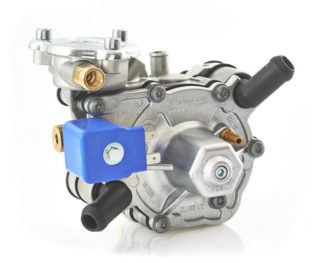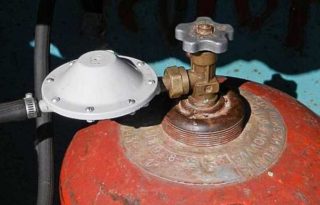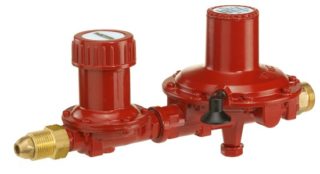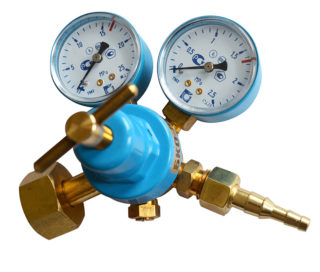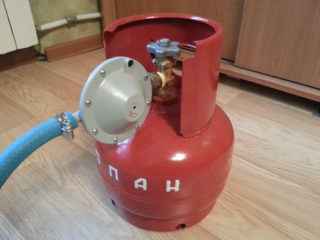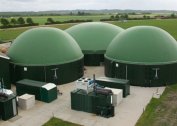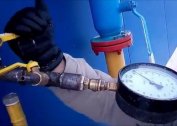In containers, the propane-butane mixture is stored under pressure, while household equipment is designed to work with a gas mixture with a pressure of not more than 0.05 atm. Gas reducer - an apparatus that regulates the pressure of the gas supplied from the tank - cylinder, gas tank - to the stove, boiler or boiler. The device reduces the pressure, and when the gas runs out in the cylinder and this indicator decreases, equalizes it.
Gas gear components
There are several types of devices. However, the regulator circuit is approximately the same. The reducer includes several elements:
- working chamber - low pressure is maintained here;
- low pressure gauge;
- the membrane of the chamber is the most important part of the regulator;
- an adjusting screw that determines the position of the membrane;
- main spring;
- high pressure chamber, where the gas mixture is supplied from the tank;
- pressure gauge;
- a fitting through which the mixture from the tank enters the gearbox;
- valve - its position is regulated by the amount of propane-butane mixture passed;
- return spring - closes the valve;
- safety valve - vents the gas if the pressure in the working chamber rises to a critical height;
- a pin connecting the check valve and the main spring.
The design may be more complex. Two-stage options more reliably support the indicator of the supplied gas and are 2 jointly operating devices. Instead of a membrane on modern devices, a pneumatic sensor is installed.
The principle of operation of the device
Distinguish between direct and reverse action devices. The principle of operation of the gas reducer is determined by the design.
In the direct-action variant, gas from the reservoir presses the valve through the nozzle, the gas mixture penetrates the high-pressure chamber. Now propane presses from the inside - presses the valve with a spring and blocks the access of the next portion of gas. The working membrane slowly returns the valve, the gas pressure decreases to the working one - the value with which the stove works.
When the pressure decreases, the spring relaxes and releases the valve. The latter opens under the pressure of the gas coming from the tank, and the entire cycle is repeated.
This type of regulator is divided into 2 types:
- Single-stage - with 1 chamber, where the pressure decreases. Minus - the indicator of gas at the outlet depends on the value at the inlet.
- Two-stage - includes 2 cameras. Gas sequentially passes through the high and working pressure chamber and only then is supplied to the stove. This design allows you to set any value at the output, regardless of the pressure in the cylinder and more accurately adjust the performance. Pressure surges are excluded.
Regulators can be equipped with additional energy supply by installing pneumatic and hydraulic sensors or electronic automatic devices.
The principle of operation of the gas pressure reducer reverse action is different. When gas enters, the valve contracts, blocking the access of the next portion of the mixture. The adjusting screw forces the base spring to compress. In this case, the membrane between the cameras bends, and the transfer disk presses on the return spring. The valve rises and passes gas from the cylinder.
In the working chamber of the gearbox, the pressure increases along with the indicator in the cylinder or pipe, through which the mixture is supplied from the gas tank.The main spring straightens the diaphragm, the transfer disk moves down and presses on the return spring. The latter again squeezes the transmission valve and shuts off the flow.
In everyday life, reverse action models are more common, as they are easy to maintain and are cheap.
Classification of gas reducers
Devices that regulate the pressure of the supplied gas are required not only in autonomous gas supply. Gearboxes are installed in numerous factory settings, in boiler rooms. They distinguish devices by design and type of gas with which they can work, as well as by purpose.
Balloon and network
Different gearboxes are required to service a gas tank, dispensing station or cylinder. At the installation site distinguish:
- Network - serve workers or welding posts powered by a central gas pipeline. The same devices are mounted in the adapter between the gas pipeline and the equipment or safety devices. The mains gear is equipped with only 1 pressure gauge that measures the outgoing gas.
- Cylinder - regulate the pressure when propane-butane or other mixture is supplied from a cylinder or from a gas holder to gas devices. They have a different design. Usually quite compact.
- Ramp - mounted on overflow ramps when it is necessary to supply gas from the main gas pipeline to the points of consumption.
The device is selected taking into account power, range of regulation, accuracy of regulation of other parameters.
Propane, Oxygen and Acetylene
If in everyday life a consumer encounters only methane or a propane-butane mixture, then in production one has to work with a wide variety of liquefied mixtures. The composition of the medium is distinguished:
- Oxygen - are used in welding metals. Gearboxes are painted in blue, mounted directly on cylinders. They are made of oxidation-resistant metal alloys and thoroughly degreased.
- Propane - used both in everyday life and in production. Painted in red. Gaskets and seals are made from materials resistant to n-pentane.
- Acetylene - are used in welding. Painted in white. They are made of metals with the exception of copper, zinc, silver. Sealers are made of materials resistant to acetone, DMF, and solvents.
- Cryogenic - designed to work with gas mixtures at temperatures below -120 C. They are made of metals resistant to cold, like brass, stainless steel.
All reducers working with combustible gases - methane, propane, acetylene - are equipped with left-hand threads, which eliminates accidental connection to the reducer.
Specifications
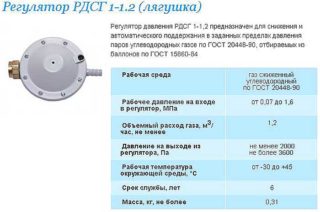 Regardless of how the gas household gearbox works, the main thing when choosing is the operating parameters of the model. The following should be considered:
Regardless of how the gas household gearbox works, the main thing when choosing is the operating parameters of the model. The following should be considered:
- Working pressure - its value is indicated in the data sheet of the device. Usually it is 0.03, 0.037 and 0.05 atm. The operating pressure of the regulator should be the same. Otherwise, the stove or boiler will not work properly.
- Maximum and minimum outlet pressure.
- Maximum and minimum inlet pressure - the parameter determines which tanks the device can work with.
- Gas flow rate - the maximum flow rate of the regulator is not standardized. However, you need to buy a device whose performance is not less than the estimated fuel consumption.
- Appointment - gearboxes from the household line are designed to service the stove, boiler and boiler in the house. Industrial are designed to work with more powerful equipment, poorly combined with household appliances. The calculation of their higher reliability is not justified.
- The adjustment range is more than enough range from 20 to 60 bar.
The reverse gear is more accurate and eliminates pressure drops during gas supply. Even better regulates the rate of a two-chamber device.However, the price of the latter is much higher.
Application area
In any area where fuel to the device comes from a cylinder or from a gas tank, a reducer is needed. Most often it is required:
- when connecting stationary portable stoves, grill;
- at arrangement of geysers and heat guns for heating;
- if gas is used as fuel for transport - in cars, on river vessels;
- for the operation of gas welding machines and torches;
- for arranging thermal umbrellas.
The reducer provides the stationary pressure of the supplied fuel and the normal operation of the devices.
Rules for handling the mechanism
Installation and inspection of gas gears is carried out by a specialist. The consumer must comply with the operating instructions written in the instructions. General recommendations include the following:
- Connect the device with the adjusting screw turned out. Before this, the cylinder valve opening is purged, and the nozzle and union nut are cleaned of dirt and oil.
- When the reservoir valve is first opened, observe the readings of the high pressure gauge. Using the adjusting screw set the required indicator of the exhaust gas.
- During breaks in operation - more than a day of absence - the valve is closed, the adjustment screw is loosened, gas is vented from the low pressure chamber.
- Screws and valves rotate smoothly, without jerking.
- Monitor the health of the pressure gauge and safety valve. When suspicious signs appear, they turn to gas workers.
It is forbidden to replace the gearbox yourself.
Reasons for Failure
Regulator malfunctions can be divided into 2 groups: removable and unrecoverable. The first include:
- Deterioration of sealing elements of connecting elements. Inserts change or seal the connection with silicone sealant. This must be done, as a leaky gasket causes a gas leak.
- Deviation in the pressure gauge at normal pressure can be caused by problems with the spring. In this case, the gearbox is disassembled and the spring inspected: displaced, replaced with a new one. If the part has lost its elasticity, lay a solid lining.
- Valve problems are caused by rubber pad wear. It is replaced with the same element from the repair kit.
- If the membrane is damaged or ruptured, the pressure gauges show the real picture. In this case, you need to replace the part.
Damage that cannot be repaired itself includes a breakdown in the pneumatic sensor. It requires the participation of a specialist.
Gearbox repair is performed when it is not possible to quickly replace it. Household models are cheap, so it’s easier to buy and install a new one.
